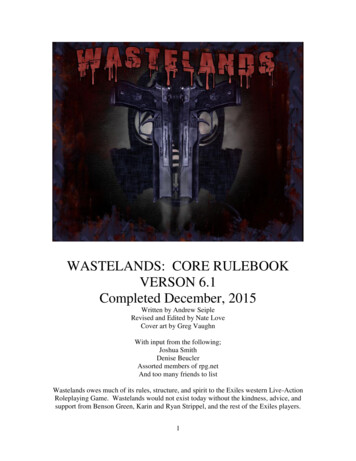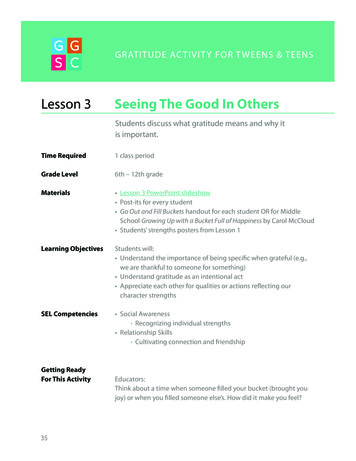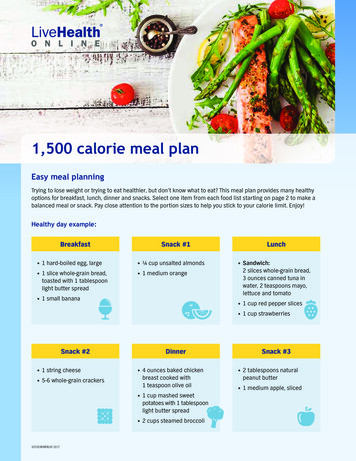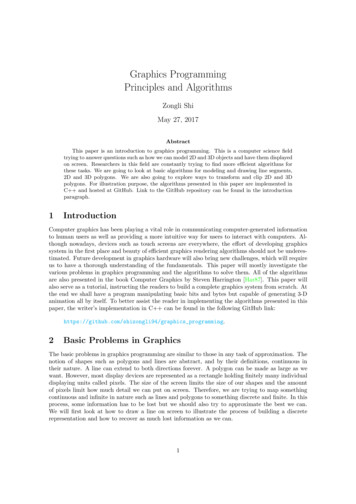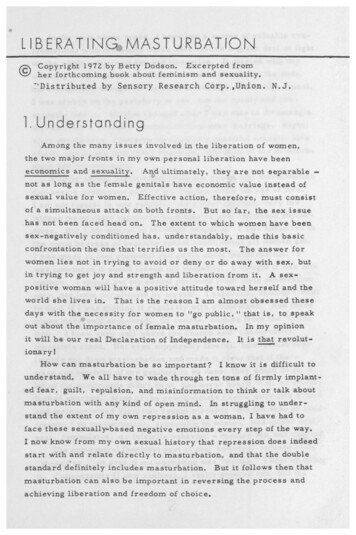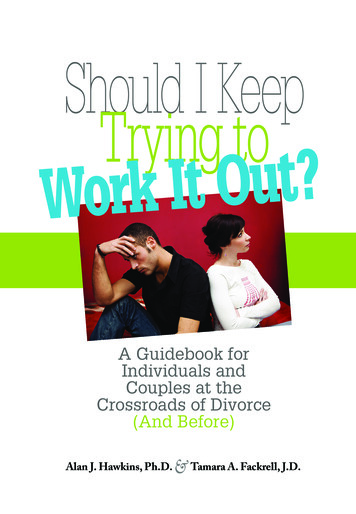
Transcription
Should I KeepTrying to?tuOtIWorkA Guidebook forIndividuals andCouples at theCrossroads of Divorce(And Before)Alan J. Hawkins, Ph.D.& Tamara A. Fackrell, J.D.
About the Authors:Dr. Hawkins, Ph.D., has been a member of the faculty in the School ofFamily Life at Brigham Young University since 1990. He is chair of the UtahCommission on Marriage, which advises the state on its efforts to help couples formand sustain healthy marriages. He has worked with the federal government in itsefforts to explore ways to strengthen marriages in our society. He is also an advisorto the National Center for Marriage Research at Bowling Green State University,the National Center for African American Marriages and Families at HamptonUniversity, and a member of the Texas Healthy Marriage Initiative Research AdvisoryGroup. He was the research hub director of the National Healthy Marriage ResourceCenter. He has published dozens of scholarly articles and three books on marriage,divorce, and fathering.Dr. Fackrell, J.D., is an Attorney Mediator in Utah. She has had a privatelaw practice since 1998 focusing on family law. She graduated cum laude fromBYU Law School and is currently part-time faculty at the law school teachingmediation. She received the Phi Alpha Delta Professor of the Year Award in2006. She has had a private mediation practice focusing on divorce and domesticmediation since 1997. Dr. Fackrell served on the Advisory Committee to theJudicial Council for the State of Utah for House Bill 4, which required mediationcontinued on inside of back cover
Should I KeepTrying to?tuOtIkrWoA Guidebook forIndividuals andCouples at theCrossroads of Divorce(And Before)Alan J. Hawkins, Ph.D.& Tamara A. Fackrell, J.D.Produced on behalf of the Utah Commission on MarriageSalt Lake City, Utah October 2009Dr. Alan Hawkins, Chair Melanie Reese, CoordinatorContentsCHAPTER TITLEPAGEChapter 1: Introduction and Overview. . . . . . . . . . . . . . . 1A. What is the purpose of this guidebook? . . . . . . . . . . . . . . . . . . . . . . . 2B. Why is a divorce orientation education class needed? . . . . . . . . . . . . . . . . 4Exercise for Chapter 1 . . . . . . . . . . . . . . . . . . . . . . . . . . . . . . . . . . . . . . 61.1: Plan Your Use of this Guidebook . . . . . . . . . . . . . . . . . . . . . . . . . . . . . . 6Chapter 2: Can unhappy marriages become happy again? How?. . . 9A. Can unhappy marriages become happy again?. . . . . . . . . . . . . . . . . . . 10B. Can couples improve their own marriages without outside help? How? . . . . . . . 11C. Are there classes that can help couples have a healthy, happy marriage?. . . . . . 12iii
CHAPTER TITLEPAGEChapter 2 Cont.Box 2.1: Self-Guided Resources Related to Marriage and Divorce . . . . . . . . . . . 13Box 2.2: Book Highlight . . . . . . . . . . . . . . . . . . . . . . . . . . . . . . . 14D. Can marriage counseling help? How can I choose a good counselor? . . . . . . . . 16Box 2.3: Well-Known Marriage and Relationship Education Programs. . . . . . . . . 16E. Do divorcing couples sometimes reconcile and get back together? When isreconciliation likely to be successful?. . . . . . . . . . . . . . . . . . . . . . . 19F. What if I’m willing to try to save my marriage but my spouse doesn’t seem willing?. 21G. What is a “healthy” marriage? . . . . . . . . . . . . . . . . . . . . . . . . . . . 22Exercises for Chapter 2. . . . . . . . . . . . . . . . . . . . . . . . . . . . . . . . . . . . 232.1: Hanging On or Moving On?. . . . . . . . . . . . . . . . . . . . . . . . . . . . . . . . 232.2: Thinking About Education to Strengthen Marriages. . . . . . . . . . . . . . . . . . . 252.3: Thinking About Marriage Counseling. . . . . . . . . . . . . . . . . . . . . . . 272.4: Thinking about Reconciliation. . . . . . . . . . . . . . . . . . . . . . . . . . 312.5: Elements of a Healthy Marriage: How Important Are They?. . . . . . . . . . . . . . . . 34Chapter 3: How common is divorce and what are the reasons?. . . 41A. What percentage of marriages end in divorce? . . . . . . . . . . . . . . . . . . . 42B. What factors are associated with a higher risk for divorce? . . . . . . . . . . . . . 42C. What are the most common reasons people give for their divorce? . . . . . . . . . 44D. Why is commitment so important to a successful marriage? . . . . . . . . . . . . 44E. Are there clearly valid reasons for divorce? Are abuse, infidelity, or addictionsvalid reasons? . . . . . . . . . . . . . . . . . . . . . . . . . . . . . . . . . . . 46Box 3.1: Signs of Abuse . . . . . . . . . . . . . . . . . . . . . . . . . . . . . . . 49F. How do individuals decide to divorce or remain married? . . . . . . . . . . . . . . 52Exercises for Chapter 3. . . . . . . . . . . . . . . . . . . . . . . . . . . . . . . . . . . . 523.1: Thinking About Your Reasons for a Possible Divorce. . . . . . . . . . . . . . . . . . . 523.2: Thinking About Commitment in My Marriage. . . . . . . . . . . . . . . . . . . . 533.3: Personal Philosophy About Divorce . . . . . . . . . . . . . . . . . . . . . . . . 593.4: Is There Abuse in My Marriage? . . . . . . . . . . . . . . . . . . . . . . . . . . 61iv
CHAPTER TITLEPAGEChapter 4: Does divorce help adults become happier?. . . . . . . . 65A. Are people happier as a result of divorce? . . . . . . . . . . . . . . . . . . . . . 66B. Does conflict between spouses decrease as a result of divorce? . . . . . . . . . . 68C. Do some who divorce later wish they had worked harder to try to save their marriage? . . 69D. What are my chances for remarrying and having a happy marriage? . . . . . . . . 71E. Is the idea of finding and marrying your “soul mate” a myth?. . . . . . . . . . . . 72Exercises for Chapter 4. . . . . . . . . . . . . . . . . . . . . . . . . . . . . . . . . . . . 724.1: Imagining A Happy Ending . . . . . . . . . . . . . . . . . . . . . . . . . . . . . . . . 724.2: Thinking About Conflict After Divorce. . . . . . . . . . . . . . . . . . . . . . . 73Chapter 5: What are the possible consequencesof divorce for children? . . . . . . . . . . . . . . . . . . . . . 75A. Why are some children more affected by divorce than others?. . . . . . . . . . . 76Box 5.1: Recommended Books about the Effects of Divorce on Childrenand Effective Parenting . . . . . . . . . . . . . . . . . . . . . . . . . . . . . . 80B. What are the possible social, emotional, and physical healthconsequences of divorce? . . . . . . . . . . . . . . . . . . . . . . . . . . . . . 80Box 5.2: Book Highlight: Raising an Emotionally Intelligent Child . . . . . . . . . . . 81C. What are the possible educational consequences of divorce?. . . . . . . . . . . . 83D. What are the possible religious and spiritual consequences of divorce?. . . . . . . 84E. What are the possible consequences of divorce for sexual behavior? . . . . . . . . 85F. What are the possible consequences of divorce on children’s future adultromantic relationships? What are the odds of divorce for children of divorce? . . . . . . . 85Exercises for Chapter 5 . . . . . . . . . . . . . . . . . . . . . . . . . . . . . . . . . . . . 865.1: How Well Might My Children Adjust to Divorce? . . . . . . . . . . . . . . . . . . . . . 86Chapter 6: What are the possible consequencesof divorce for adults? . . . . . . . . . . . . . . . . . . . . . . 93A. Why do some adults thrive and others struggle after divorce? . . . . . . . . . . . 94B. What are the possible emotional and physical health consequences of divorce? . . . 96C. What are the possible consequences of divorce for social support? . . . . . . . . . 97D. What are the possible consequences of divorce for religious involvement?. . . . . 99E. What are the possible consequences of divorce for romantic relationships? . . . . 100F. What are the possible consequences of divorce for your relationshipwith your ex-spouse? . . . . . . . . . . . . . . . . . . . . . . . . . . . . . . 101v
CHAPTER TITLEPAGEChapter 6 Cont.Exercises for Chapter 6 . . . . . . . . . . . . . . . . . . . . . . . . . . . . . . . . . . . . 1026.1: How Will Divorce Affect Me Personally? . . . . . . . . . . . . . . . . . . . . . . . . . 102Chapter 7: What are the possible financial consequencesof divorce?. . . . . . . . . . . . . . . . . . . . . . . . . . 109A. What are the possible financial consequences of divorce for women and children? . . . . 110B. What are the possible financial consequences of divorce for men? . . . . . . . . . 111C. What is the financial impact of divorce on communities and taxpayers?. . . . . . 112Exercises for Chapter 7 . . . . . . . . . . . . . . . . . . . . . . . . . . . . . . . . . . . . 1127.1: Exploring the Financial Impact of Divorce. . . . . . . . . . . . . . . . . . . . . . . . . 112Chapter 8: What are the legal options for divorce?What should I expect during the divorce process?. . . . . . . .121A. What should I expect going through the negotiated divorce process? . . . . . . . 122B. Does getting a divorce require a lawyer or can I get a divorcewithout the help of a lawyer?. . . . . . . . . . . . . . . . . . . . . . . . . . . 123C. What does it cost to get a divorce? . . . . . . . . . . . . . . . . . . . . . . . . 124D. What is divorce mediation? And what are the financial consequencesof choosing mediation services for a divorce? . . . . . . . . . . . . . . . . . . . 125E. What is collaborative law? How does it work in a divorce? . . . . . . . . . . . . . 127F. What if I don’t want the divorce? Can I challenge a divorce in court? . . . . . . . . 128Exercises for Chapter 8 . . . . . . . . . . . . . . . . . . . . . . . . . . . . . . . . . . . . 1298.1: Thinking About Parenting Time with Children. . . . . . . . . . . . . . . . . . . . . . 1298.2: Thinking About Child Support and Alimony. . . . . . . . . . . . . . . . . . . . . . . 1328.3: Preparing for Divorce Mediation. . . . . . . . . . . . . . . . . . . . . . . . . . . . . 134Resource List for Separated and Divorced Families . . . . . . . . 136A Summary of Key Points in this Guidebook. . . . . . . . . . . .138Endnotes . . . . . . . . . . . . . . . . . . . . . . . . . . . . 140vi
1.Introduction and OverviewDivorce is such a gut-wrenching experience, and there isn’t anyone Iknow that hasn’t come through it with their whole world just turnedupside down.—“Janet,” a divorced, single momOverview: In this chapter you will learn about the general purpose of thisguidebook. It is designed to be a resource to individuals at the crossroads of divorce,that is, for individuals who are thinking about divorce or whose spouse is thinkingabout divorce. You will learn about the requirement in Utah for divorcing parents toparticipate in a divorce orientation education class intended to help individuals atthe crossroads of divorce understand the effects of divorce, and to carefully considertheir options, including repairing their relationship and keeping their family together.You will also learn why the Utah Legislature thought this class would be valuable,including information about the number of divorces in Utah, the estimated costs tothe taxpayers of divorce, and a brief summary of the effects of divorce on children andadults.James and Shelly (names have been changed) were considering divorce. They havethree children. As with many couples who divorce, they had a big fight. Shelly wantedto divorce, but James wanted to save the marriage. Shelly had a long list of issues thatthe couple needed to work on. She had rarely been open about her disappointment intheir marriage, but there had been a few frank conversations over the years. After the bigfight, Shelly took the children an hour away from her home to her mother’s house. Shellywanted to think carefully about her options as she decided how to proceed.Hilary and Sam had come to a crossroads in their marriage. Hilary was an alcoholic.Sam decided he was ready to move on and divorce. Hilary wanted to work through themarital issues. She promised that this time, she would get her addiction in check. ThisShould I Keep Trying to Work it Out?1
was a second marriage for both of them and they each had children from their previousmarriages, as well as children in the current marriage.Felicia and Rolando were also at the crossroads of divorce. Felicia had yelled aboutan issue regarding their children. Rolando had stayed calm, but Felicia was heartbrokenand refused to talk about the problem. The couple separated abruptly and Felicia tookthe children with her. They needed to decide if this separation was going to become apermanent fixture in their lives.This guidebook is a way to help couples like Sam and Hilary, James and Shelly,and Felicia and Rolando make important choices that come when a couple is decidingbetween working through marital problems or divorcing.A. What is the purpose of this guidebook?This guidebook is designed to be a resource to individuals who may be thinking aboutgetting a divorce or whose spouse is thinking about divorce. These individuals are at the“crossroads of divorce,” facing a challenging decision that has powerful consequencesfor the future of their own lives, the lives of family members, and their communities.This guidebook contains research-based information about important questions thatindividuals at the crossroads of divorce often have, such as: Can my marriage be repaired and can we be happy again? Is divorce a dependable path to happiness? What are the effects of divorce on children, adults, and the communities they livein? What can I expect will happen during the legal process of getting a divorce? What are the legal options for ending a marriage?We try to answer these kinds of questions and many more in this guidebook.We know that these are sensitive and difficult questions to answer. Circumstancesare different for everyone. We believe there are valid reasons for a divorce. And manyindividuals going through divorce want to keep working to save the marriage but theirpartners do not. The law allows one partner to end a marriage without the consent of hisor her spouse. We try in this guidebook to be sensitive to different situations. It is not ourintention to make judgments about what individuals should or should not do in difficult,personal circumstances.At the same time, we try to present the scientific research on marriage anddivorce accurately and fairly. And the research is clear that, in general, the process offamily breakup marked by divorce has potential problems for children, adults, andthe communities they live in. In some instances, divorce actually improves the lives of2Chapter 1: Introduction and Overview
those involved, but for the most part, researchers have found that divorce generally hasnegative effects. Also, research suggests that some—maybe even many—individuals atthe crossroads of divorce may be able to repair their marriages and avoid those potentialnegative consequences. A lot of good research identifies the knowledge and skills thatindividuals need to form and sustain a healthy and happy marriage. And there are goodresources available to help those who want to work to keep trying to improve theirrelationship. If you decide to divorce, there are legal options to consider that may be betterfor you and your children. This guidebook can give you solid information that will helpyou make good choices in your individual circumstances.In 2007, the Utah Legislature passed a first-of-its-kind law to require individualswho file for a separation or divorce and who have children under 18 years old toparticipate in a divorce orientation education class. The purpose of the class is to helpindividuals considering a divorce to think carefully about their options, includingrepairing problems in the marriage and keeping a family together, and to informindividuals of the potential consequences of divorce. The class also informs people of theirlegal options for divorce. This guidebook can be an additional resource for individuals whotake the divorce orientation education class.We hope this Crossroads of Divorce guidebook can be useful to people in othercircumstances, as well. For instance, individuals who may not be thinking too seriouslyabout divorce but are experiencing the struggles and disappointments that almostall married couples face could be motivated to work to improve their relationship toavoid the challenges of divorce. Some maybe thinking more seriously about divorceResearch suggests thatbut haven’t taken any formal steps in thatdirection. This guidebook can be a valuablesome—maybe even many—source of information for those individuals,too. Sometimes family members and friendsindividuals at the crossroadswho are watching loved ones strugglingof divorce may be able towith their marriages want valid information,like the information in this guidebook, torepair their marriages andshare with loved ones. In addition, perhapsavoid potential negativethe information in this guidebook canhelp those who have already experienced aconsequences.divorce understand some of the challengesthey have faced and better prepare for futurerelationships. Marriage counselors, religiousleaders, and mediators who are working with couples facing a possible divorce may wantto use or recommend this guidebook. And because most people think that divorce is aserious problem in our society, this guidebook has general educational value; it is notlimited just to those who are currently going through a divorce.Should I Keep Trying to Work it Out?3
Using This Guidebook. There is a lot of information in this guidebook.You may be more interested in some parts and less interested in others. We don’t assumeyou will read the entire guidebook, so there may be some repetition of information inthe various chapters. Select the parts that are most helpful to you. You may want to lookover the table of contents to see which parts might be most helpful. Brief overviewsare at the beginning of each chapter. In addition to all the research that is presented,sprinkled throughout the guidebook are stories and quotations from real people we haveinterviewed in Utah and a handful of other states who have been at the crossroads ofdivorce, telling how they handled their challenges, what they decided to do, and howthings have worked out for them. Stories like these put a more human face on the difficulttopic of repairing a marriage or getting a divorce than you get from all the researchfindings we present. (We have changed the names of these individuals to preserve theirprivacy.)Also, at the end of each chapter, there are some exercises or self-guided activities sothat you can evaluate your own situation and think about your best course of action. Theseexercises are one of the most valuable parts ofthe guidebook. Sometimes at the crossroads ofdivorce people can be caught up in emotionsThe exercises provided init can be difficult to sort out your thoughtsthis book may help you think and feelings. Moreover, they often lack helpfulinformation about marriage and divorce. Inmore clearly about yourthese situations, people often make decisionsthat satisfy them for the short run but maydecision to divorce or not tonot be an optimal decision for the long run. Ifyou take the time to do these exercises, theydivorce.may help you think more clearly about yourdecision. We encourage you to do Exercise 1.1,“Plan Your Use of This Guidebook,” at the endof this chapter. It will help you get an overview of the guidebook and encourage you toplan your use of it.Many students, research assistants, and colleagues provided us with help andguidance while writing this guidebook. We are grateful to them for their help andcontributions. In addition, members of the Utah Commission on Marriage that overseesthe Utah Healthy Marriage Initiative reviewed this guidebook and made suggestions.They endorsed this guidebook. But we, as the authors, take responsibility for the content.B. Why is a divorce orientation education class needed?When the Utah Legislature passed the divorce orientation education legislation,they wanted to encourage Utahns thinking about a divorce to consider their optionscarefully. After careful consideration, if some marriages can be repaired and familiesremain intact, then everyone probably is better off. If individuals choose a divorce, thenit is important for them to be well informed of what to expect and what legal options areavailable.4Chapter 1: Introduction and Overview
The Utah Legislature is concerned with the number of divorces in Utah and theeconomic, social, and personal costs involved. There are about 10,000 divorces a year inUtah,1 and a little more than half (52%) of these divorces involve children.2 About onein five (18%) Utahns have ever been divorced.3 Furthermore, nearly one in three (29%)married Utahns report that they thought their marriage had, at some point, been inserious trouble and had thought about divorce.4 More than 90% of Utahns think thatdivorce is a serious problem in our society.5 In addition to the personal costs of divorce tofamilies, a recent study from Utah State University estimated the financial costs of Utahdivorces to Utah taxpayers to be more than 180 million a year, or about 18,000 perdivorce.6 A lot of these costs come from the fact that divorce is one of the most commonways that adults and children fall into poverty and thus receive some governmentassistance.7 Another, more rigorous national study conservatively estimated the costnationwide of family fragmentation—divorce or having children without marrying—tobe 112 billion a year, and the cost to Utah taxpayers was estimated to be about 276million a year.8For these reasons, the Utah Legislature has required that divorcing parents, beforeproceeding with a divorce, be given information that may help them decide if a divorceis the right thing for them, give them resources for how to improve their relationship,or help them be better prepared for the challenges of a divorce. A recent survey of 2,000California adults showed that more than 80% agreed that when a married couple withchildren is considering a divorce, they should be required to attend some kind of marriageeducation class or counseling before the divorce is granted.9 We suspect that Utahns’attitudes are similar. Indeed, one Utah divorced single parent—“Brittany”—shared withus her strong personal feelings about this idea:What would I share with those who are approaching the decision of divorce?Explore every single avenue possible. . . . I think that it should be required that theygo to a full-day, 8-hour course on “this is what happens [with divorce], this is howmany days you get [with your kids], these are the holidays you get, this is how manydays a year you get to see them. This is how this works.” . . . I truly think that peoplestart the process [of divorce] but they don’t know what the ramifications are, butonce they find out what the ramifications are, they are in it so far, that they don’twant to go backwards. So if they knew up front how it was going to work, andwhat would happen to the kids, and the cost, I think people would be more apt to tryharder. I think it should be required that they go to a course before they even file [fordivorce].We believe that you and your children deserve nothing less than carefulconsideration of whether divorce is the right thing to do and to make that decisionbased on the best information possible. We encourage you to take the time to review theinformation and do the exercises in this guidebook. Whatever your decision, we wish youand your family the best.Like James and Shelly, in the example at the beginning of the chapter, you maydecide that counseling will help you make a more sound decision. James attendedShould I Keep Trying to Work it Out?5
counseling on his own to help him work through some personal issues that hadcontributed to his marital problems. James and Shelly ultimately decided to stay togetherand over time rebuilt a happy marriage. Or, like Hilary and Sam, you may decide todivorce and carefully consider your options of how best to proceed. Hilary and Sam usedthe divorce mediation process to amicably resolve all of the issues in their divorce. Theycontinued to work well together as co-parents for the sake of their children. We hopeyou won’t be like Felicia and Rolando, whose emotions drove them almost unthinkinglytoward divorce, blocking any communication with each other and preventing any attemptto salvage civility in the relationship even though they will be co-parents to their childrenfor the rest of their lives. They fought an expensive battle in court and the litigation overthe children continued as each of them remarried.If parents decide to divorce, the Utah Legislature requires them to take anotherbrief course to help them make plans to minimize the negative effects of divorce on theirchildren. The course to help divorcing parents minimize the negative effects of divorce isdifferent from (and in addition to) the required divorce orientation education class that isdesigned to help individuals at the crossroads of divorce carefully consider their options.Exercise for Chapter 11.1: Plan Your Use of this Guidebook.Often it is a good idea to start an activity with a goal and a plan. We invite you to dothat for this guidebook. First, we suggest you look over the Contents on pages 3-4 to geta better idea of the specific topics included in the guidebook. The various chapters andsections of each chapter are titled with a question that people at the crossroads of divorceoften have. Next, you may want to skim the overview at the beginning of each chapteryou have noticed to see if it is something you are interested in. Then think about howvaluable the information in the chapter will be to you. If you believe it will be valuable,make a plan to go over the material and complete some of the activities.Using the guidelines below, for each chapter indicate how important you think theinformation will be to you (circle the number for your answer). Then, indicate when youwould like to have read the material and completed some or all the activities. Pleaseconsider carefully; make this a contract with yourself to help you think clearly at thischallenging crossroad in your life.Then, after doing this, pause for a moment and think about your overall goal for thisguidebook. Perhaps you seriously want to think about working more on your relationshipand avoiding divorce, so your goal may be to find ways to do this. Perhaps you don’thave much choice—the divorce is being forced on you—so maybe your goal is to betterunderstand what might have gone wrong in your marriage and learn what you can dobetter the next time. Whatever your goal might be, write it down.6Chapter 1: Introduction and Overview
Chapter 2: Can unhappy marriages become happy again? How?How important do you think this chapter willbe to you?1NotImportant2SomewhatImportantWhen will you read it and work on the activities?3PrettyImportant4VeryImportantFinish date goal:Chapter 3: How common is divorce and what are the reasons?How important do you think this chapter willbe to you?1NotImportant2SomewhatImportantWhen will you read it and work on the activities?3PrettyImportant4VeryImportantFinish date goal:Chapter 4: Does divorce help adults become happier?How important do you think this chapter willbe to you?1NotImportant2SomewhatImportantWhen will you read it and work on the activities?3PrettyImportant4VeryImportantFinish date goal:Chapter 5: What are the possible consequences of divorce for children?How important do you think this chapter willbe to you?1NotImportant2SomewhatImportantWhen will you read it and work on the activities?3PrettyIm
the taxpayers of divorce, and a brief summary of the effects of divorce on children and adults. James and Shelly (names have been changed) were considering divorce. They have three children. As with many couples who divorce, they had a big fight. Shelly wanted to divorce, but James wanted to save the marriage. Shelly had a long list of issues that
